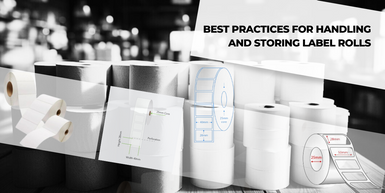Posted by LabelWarehouse on 16th May 2024
Best Practices for Storing and Handling Label Rolls in Industries
In industries that rely on labelling for packaging and product identification, such as food manufacturing, proper handling and storage of label rolls are essential for maintaining operational efficiency, ensuring product quality, and upholding brand integrity. For example, in a food production setting, correctly stored label rolls prevent issues like label curling or adhesive failure, minimising production disruptions and ensuring accurate product information. Clear and precise labelling not only meets regulatory requirements but also enhances customer perception and brand credibility. Moreover, implementing best practices in label roll management reduces material wastage and operational costs, ultimately contributing to a streamlined production process and optimised resource utilisation.
In this blog, we have discussed the correct ways of storing labels to preserve their functionality and effectiveness.
Let’s get started!
Temperature and Humidity: Best Practices for Storing Labels
It's really important to keep thermal labels in the right conditions to make sure they last and work well. The best place to store them is in a cool, dry spot where the temperature stays between 65°F to 75°F (18°C to 24°C) and the humidity is around 45% to 55%. If thermal labels are exposed to very high or low temperatures or lots of humidity, they can start to bend or warp, the adhesive might not stick properly, and the print quality can go down.
Climate-Controlled Storage for Thermal Labels
Store thermal labels in a room or space that's climate-controlled, meaning it has air conditioning and humidity control. This setup helps keep the temperature and humidity steady, no matter what the weather's like outside.
Using Desiccants for Humidity Control
If you're in a place with lots of humidity, like a damp environment, think about using desiccant packs or materials that absorb moisture. This helps to keep the moisture level inside the storage containers just right for the labels. Make sure the area where you store labels is well-insulated and sealed up properly. This keeps the temperature stable and stops moisture from getting inside.
Preventing Sunlight Damage to Labels
Don't put label storage where it gets direct sunlight or near sources of heat. Sunlight can make the labels fade and damage the material they're made from.
Exposure to Light: How to Protect Thermal Labels
Thermal labels can be affected by UV light, which can cause the printed content to fade over time. If they're exposed to sunlight or bright indoor lights for too long, the labels can start to fade quickly. This makes it hard to read or scan the information on them. So, it's best to keep thermal labels away from direct sunlight and bright lights to preserve their clarity and quality.
Using Opaque Containers for Light Protection
Keep thermal label rolls in containers or boxes that don't let light through to shield them from light exposure. This helps block UV rays and keeps the print quality intact.
Finding the Best Storage Location to Minimize Light Exposure
Store labels away from windows and bright areas. Pick a dark and shaded spot to minimise light exposure and protect the labels.
Using Light-Blocking Sleeves for Label Rolls
If you have individual label rolls or sheets, use sleeves or packaging that blocks light to add extra protection against light exposure.
Duration of Storage: Maximising Label Shelf Life
Thermal labels usually last between 6 months to 1 year, but this can vary based on the type of label and storage conditions. Over time, the adhesive on the labels can weaken, which might cause problems when you try to apply them.
FIFO Method: Using Oldest Labels First
When managing label inventory, follow a "First In, First Out" (FIFO) rule. This means using the oldest label rolls first to make sure they get used before they expire.
Checking Label Expiry Dates Regularly
Keep an eye on your label stock regularly to see how much you have and when labels are getting close to expiring. This way, you can use or get rid of them in time to avoid waste.
Choosing Suppliers with Clear Label Date Information
Choose suppliers who give clear information about when labels were made. This helps you manage your inventory better and use labels in the right order.
Top Storage Solutions for Label Rolls
There are different types of storage solutions for businesses to choose from.
Using Shelving Units for Efficient Label Storage
Strong shelving units are a great way to store labels. They have plenty of space to keep label rolls and sheets organised, so you can find the labels you need easily.
Organising Labels with Label Cabinets
Label cabinets are made specifically for storing labels. They provide enclosed and secure spaces to keep labels safe from damage and environmental conditions.
Compact Storage Options: Label Organisers
Compact label organisers are perfect for smaller storage needs. They usually have dividers and compartments to help you neatly organise your label rolls.
Label Storage Drawer Systems: A Smart Solution
Using drawers with dividers is a smart way to sort labels efficiently, especially if you have different sizes and types of labels to store.
Conclusion: Optimising Label Storage for Maximum Efficiency
By implementing these best practices for handling and storing label rolls, businesses can minimise waste, maintain label quality, and optimise operational efficiency. Properly stored label rolls ensure reliable performance and contribute to overall product and operational quality in various industries.
If you are looking to buy the best label rolls at competitive prices, Label Warehouse is your one-stop shopping destination. Browse through our inventory and purchase the best label rolls to meet your business requirements perfectly.

